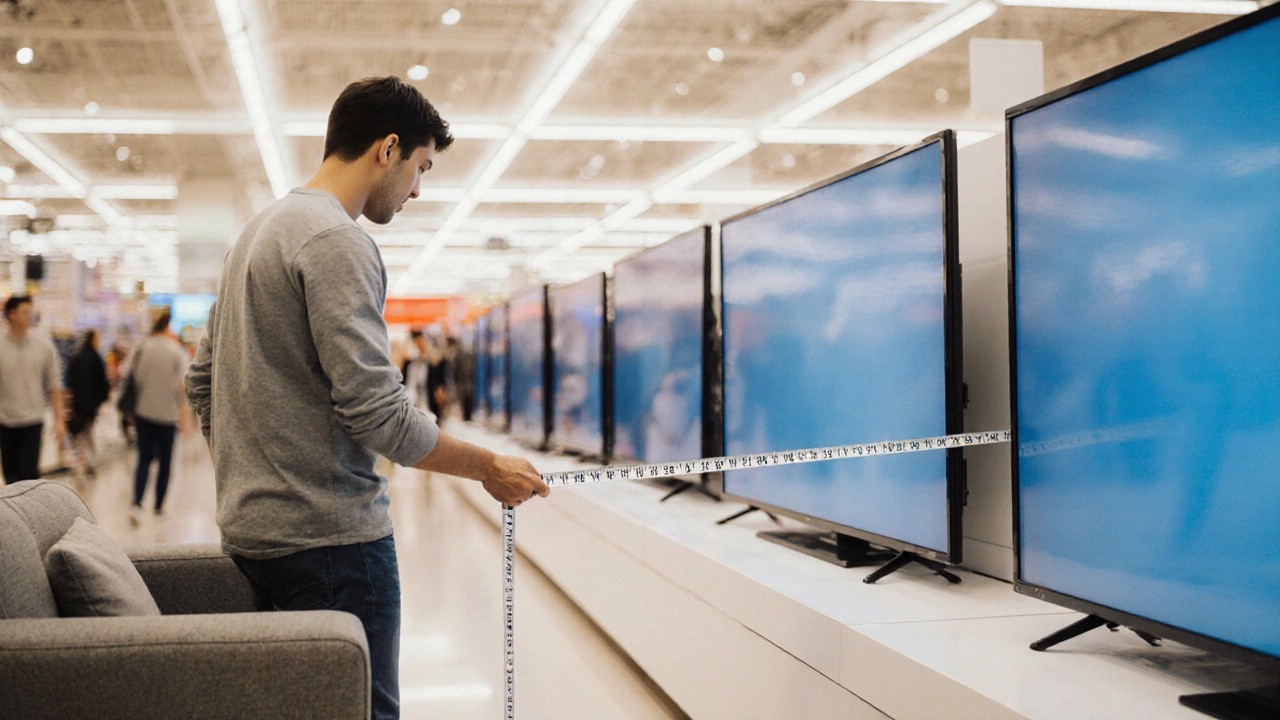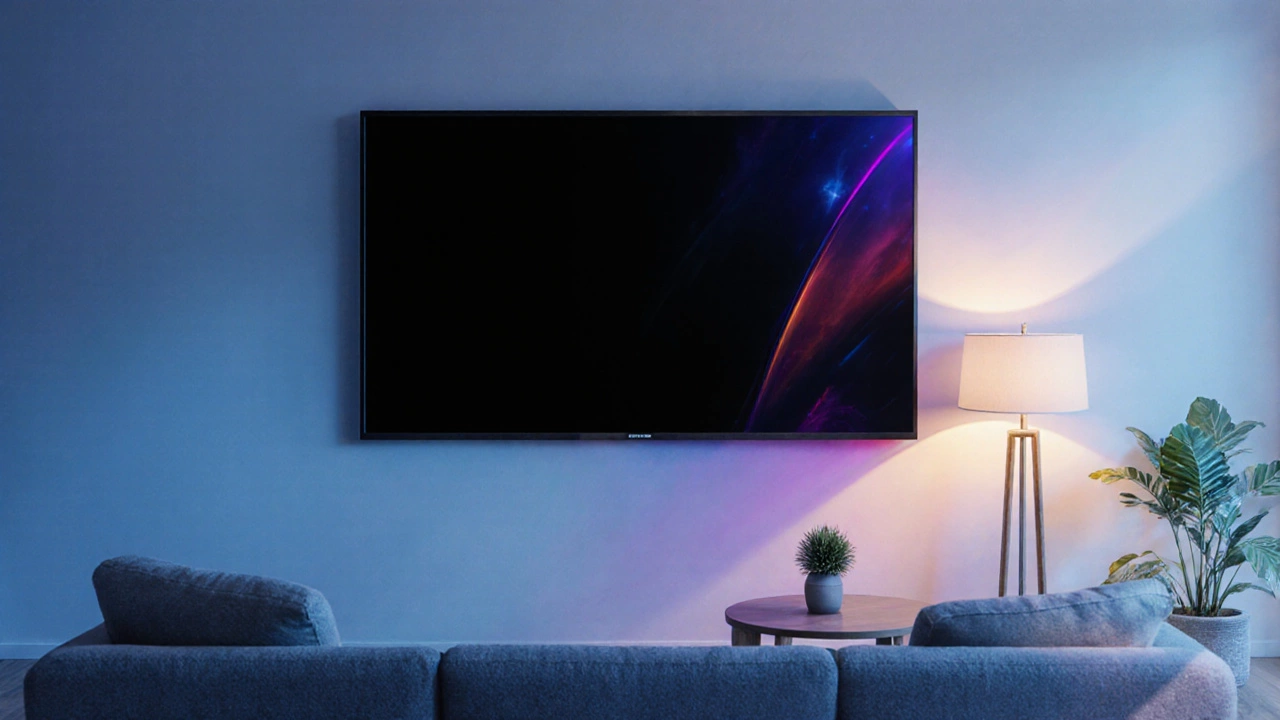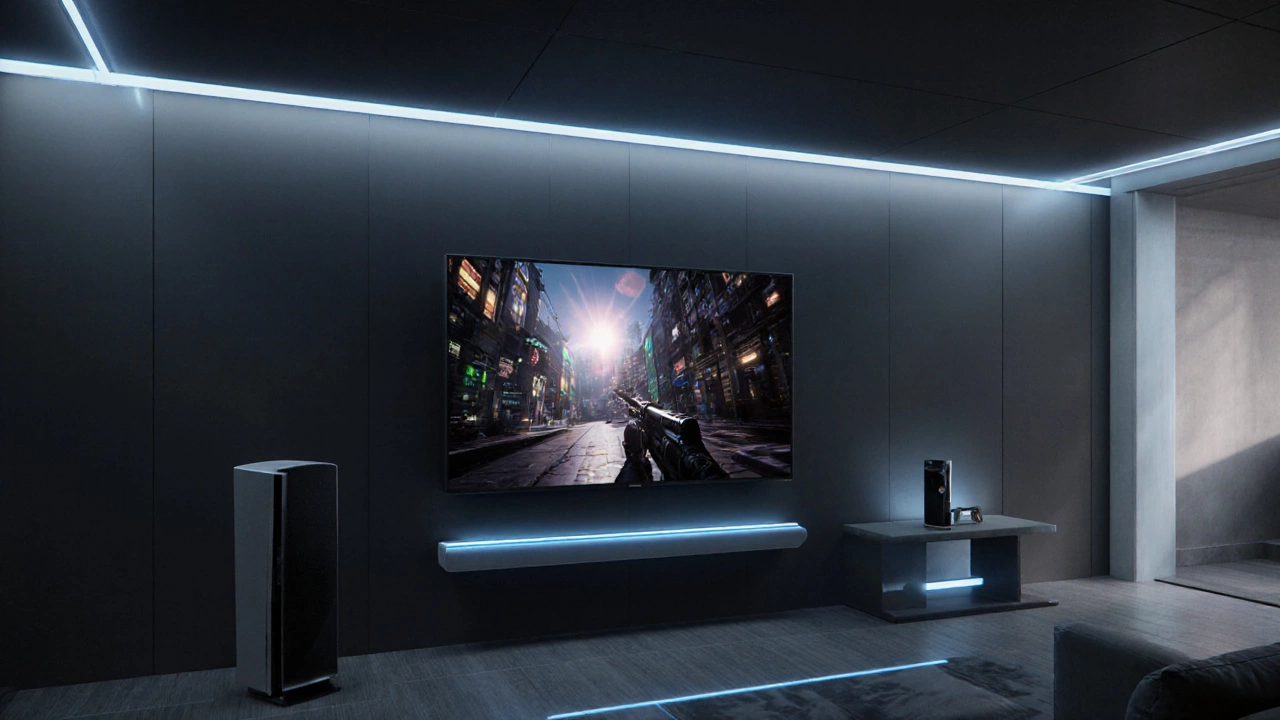
TV Size Calculator
Recommended TV Size:
Enter your viewing distance and click "Calculate" to see the recommended TV size.
Size Reference Chart:
| Viewing Distance (feet) | Recommended Diagonal (inches) | Typical Model Example (2025) |
|---|---|---|
| 4–5 | 40–50 | Samsung Q60B 50" QLED |
| 5–6 | 50–60 | LG C3 55" OLED |
| 6–8 | 60–75 | Sony A95K 70" Mini-LED |
| 8–10 | 75–85 | Hisense U8H 85" ULED |
| 10–12 | 85–100 | LG Z9 97" 8K OLED |
Choosing the right television can feel like solving a puzzle without a picture of the finished result. You walk into a store, stare at rows of massive screens, and wonder: TV size guide. The truth is, the perfect size depends on a handful of easy‑to‑measure factors, not just your budget or the latest hype. Below you’ll find a step‑by‑step rundown that turns a vague gut feeling into a clear, confident decision.
Understanding Viewing Distance
Before you even think about inches, figure out how far you’ll sit from the screen. The rule of thumb for a comfortable experience is to sit at a distance that’s 1.5 to 2.5 times the TV’s diagonal measurement. That range balances immersion with eye comfort.
Consider a typical living‑room layout: a sofa 8feet (2.44m) from the wall. Using the lower end of the range (1.5×distance), the ideal diagonal is 8ft ÷ 1.5 ≈ 5.3ft, or about 64inches. Push the distance a bit farther, and a 75‑inch screen becomes a natural fit.
Viewing distance is a measure of how far the primary seating position sits from the TV screen. Measuring this accurately-using a tape measure or simply counting the number of couch cushions-gives you the first solid data point.
How Resolution Impacts Perceived Size
Resolution tells you how many pixels fill the screen. With 4K (3840×2160) becoming the baseline for new TVs, you can sit closer without noticing individual pixels. That means the same viewing distance can comfortably accommodate a larger screen.
For example, a 65‑inch 4K TV at 6feet looks sharper than a 55‑inch 1080p set at the same spot. If you’re eye‑testing a TV in a showroom, step right up-higher resolution lets you appreciate finer detail at shorter distances.
Resolution is a count of distinct pixels arranged horizontally and vertically on a display. The higher the resolution, the smaller each pixel, which reduces the "screen‑door" effect when you’re close.
Aspect Ratio and Content Types
Most modern TVs use a 16:9 aspect ratio, matching the majority of streaming and broadcast content. Some premium models offer a slightly taller 21:9 “cinema” mode for movie‑theater experiences, but they sacrifice part of the vertical space for standard TV shows.
If you watch a lot of films shot in widescreen (2.39:1), a 21:9 screen can eliminate the black bars, creating a true‑to‑film feel. However, everyday TV shows and sports are optimized for 16:9, so a standard aspect ratio remains the safest all‑round choice.
Aspect ratio is a proportion between a screen’s width and height. Matching the aspect ratio to your most‑watched content reduces letterboxing and maximizes usable screen area.

Room Layout & Mounting Considerations
Even the perfect diagonal can feel off if the TV doesn’t fit the room’s geometry. Measure the wall width, consider window placement, and think about how the TV will be mounted.
- Wall‑mount vs. stand: A wall‑mounted screen can be larger because it doesn’t need space for a base. Just ensure the mount supports the TV’s weight and VESA pattern.
- Eye level: The ideal center of the screen sits at eye level when you’re seated. Tilting a large screen too high can cause neck strain.
- Viewing angle: OLED and QLED panels maintain color accuracy up to 30‑45° off‑axis, so you have flexibility in couch placement.
Mounting type is a method of attaching a TV to a wall or stand, influencing ergonomics and room aesthetics. Choosing a low‑profile fixed mount often yields the cleanest look for large screens.
Practical Size Recommendations
Below is a quick‑reference chart that translates your measured viewing distance into a recommended TV diagonal. The ranges are generous; pick a size that feels right for your space.
| Viewing Distance (feet) | Recommended Diagonal (inches) | Typical Model Example (2025) |
|---|---|---|
| 4‑5 | 40‑50 | SamsungQ60B 50" QLED |
| 5‑6 | 50‑60 | LGC3 55" OLED |
| 6‑8 | 60‑75 | SonyA95K 70" Mini‑LED |
| 8‑10 | 75‑85 | HisenseU8H 85" ULED |
| 10‑12 | 85‑100 | LGZ9 97" 8K OLED |
These numbers assume a 4K or higher resolution. If you’re buying a 1080p set, stay at the lower end of each range to avoid pixelation.
HDR is a high‑dynamic‑range technology that expands contrast and color range for more lifelike images. Modern 4K TVs support HDR10, Dolby Vision, or both, and larger screens benefit more visibly from the extra brightness.
Smart Features & Future‑Proofing
What you watch today is likely to shift toward streaming platforms tomorrow. Look for a TV with a robust operating system (webOS, Android TV, or Tizen) and at least three HDMI2.1 ports if you plan on connecting next‑gen consoles.
Voice assistants (Google Assistant, Alexa, Siri) are now built into many sets, allowing hands‑free control of volume, channel, and smart‑home devices. If you’re a gamer, a low input lag (under 15ms) and a variable refresh rate (VRR) become essential specs.HDMI ports are digital connectors that transmit video, audio, and control signals between a TV and external devices. HDMI2.1 adds bandwidth for 8K video, high frame‑rate gaming, and eARC audio.

Common Pitfalls to Avoid
- Oversizing for a small room: A 85‑inch screen in a 6‑foot viewing area can cause eye strain and make fast motion look jittery.
- Ignoring room lighting: Ultra‑bright rooms benefit from a TV with higher nits (e.g., 1000nits) and anti‑glare coatings.
- Skipping firmware updates: Many smart‑TV bugs-like app crashes-are fixed via OTA updates, so choose a brand with a good track record of support.
- Forgetting sound: Bigger screens often come with thin panels, which can compromise built‑in speaker quality. Budget for a soundbar or AV receiver if audio matters.
Key Takeaways
- Measure the exact distance from your primary seat to the wall; multiply by 0.4-0.6 to get a safe diagonal range.
- 4K resolution lets you lean toward the larger end of that range without pixelation.
- A 16:9 aspect ratio stays versatile for most content; only choose 21:9 if you’re a cinephile.
- Plan the mounting method early-wall‑mounts free up floor space and allow larger panels.
- Pick a TV with at least three HDMI2.1 ports, good HDR support, and a future‑ready OS.
Frequently Asked Questions
How far should I sit from a 65‑inch 4K TV?
For a 65‑inch 4K set, aim for a viewing distance between 5.5ft (1.5×diagonal) and 8.5ft (2.5×diagonal). This range gives a cinematic feel while keeping pixel density high enough to avoid visible blocks.
Does a larger screen always mean a better picture?
Not necessarily. Picture quality depends on panel type (OLED, QLED, LED), HDR capability, and processing algorithms. A smaller, higher‑grade OLED can outperform a larger, lower‑grade LED, especially in black levels and color accuracy.
Should I install a wall‑mount or keep the TV on a stand?
If you have enough wall space and want a clean look, a wall‑mount is ideal-especially for larger screens that might dominate a stand. Just verify the mount’s weight rating and VESA pattern match your TV’s specifications.
What HDR format should I look for?
HDR10 is the baseline and works on all 4K TVs. Dolby Vision adds dynamic metadata for frame‑by‑frame optimization, delivering deeper blacks and brighter highlights. If your budget allows, choose a model that supports both.
Is a 120Hz panel worth the extra cost?
A 120Hz refresh rate smooths fast motion, which is noticeable in sports and gaming. If you primarily watch movies or static shows, 60Hz is adequate. Gamers and sports fans benefit most from the higher refresh rate.